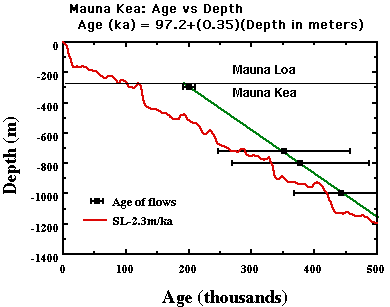
Warren D. Sharp2, Brent D. Turrin(1,2), Marvin A. Lanphere1, and Paul R. Renne2
1U.S. Geological Survey, 345 Middlefield, Road
2Berkeley Geochronology Center, 2455 Ridge Road, Berkeley, CA 94709
The top and bottom points are Ar/Ar ages for R164 (200.6+/-10.0 ka, 299m), flow unit 49 (stratigraphic description) and R446 (447+/-75 ka, 995m) flow unit 211 (stratigraphic description) . The middle two points are K/Ar ages for R340 (352+/-105 ka, 720m) flow unit 147 (stratigraphic description) and R371(378+/-109 ka, 799m) flow unit 164 (stratigraphic description) from Marv Lanphere. (Two other samples, R315, flow unit 132 (stratigraphic description) and R452, flow unit 218 (stratigraphic description), yielded 40Ar * <1%, too low to for meaningful ages.)
The red line is the sea-level curve based on the oxygen isotope record of deep-sea sediments (Bassinot et al., 1994). We have assumed that the oxygen isotope record is porportional to sea-level and that the sea-level during the last low stand was -125m. In addition to the constraints provided by the radiometric ages, the accumulation curve must lie above the sea-level curve because all the Mauna Kea flows from the core are subaerialOur electron microprobe data reveal that the K/Ar systematics of R164, flow unit 49 (petrographic description) is dominated by feldspar, especially small Or-rich patches, which should be very reliable material. In flow unit 211, R446 (petrographic description), the few per cent of glass present dominates the K/Ar budget because it contains as much as 4.3% K2O. The glass appears isotropic in thin section and the coherence of the age for R446 with respect to the other data is encouraging.
The equation above corresponds to an average accumulation rate is about 2.86 mm/year and the average recurrence interval for this location is 1,375 years (ie. the average time between emplacement of flows). This is based on the assumption that the lithologic/flow units designated in the lithologic column represent single flows.
We have a new round of samples back from irradiation which include R174, R177, R208, R350, R423, and R428.
Date created:04/05/1995
Last modified: 02/27/2003